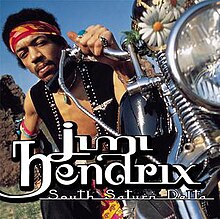Loading AI tools
1997 compilation album by Jimi Hendrix From Wikipedia, the free encyclopedia
South Saturn Delta is a posthumous compilation album by American rock musician Jimi Hendrix. Released in 1997 by Experience Hendrix (operated by his estate), it consists of material such as demo tapes, unfinished takes and alternate mixes, and previously released material, most of which Hendrix had been working on prior to his death in 1970.
| South Saturn Delta | ||||
|---|---|---|---|---|
 | ||||
| Compilation album by | ||||
| Released | October 7, 1997 | |||
| Recorded | July 1967 – August 1970 | |||
| Studio |
| |||
| Genre | ||||
| Length | 65:47 | |||
| Label | MCA | |||
| Compiler |
| |||
| Jimi Hendrix chronology | ||||
| ||||
Released prior to South Saturn Delta, First Rays of the New Rising Sun was Experience Hendrix's attempt at presenting Hendrix's planned fourth studio album.[1] The album consists of songs previously released on his first posthumous albums The Cry of Love (1971), Rainbow Bridge (1971), and War Heroes (1972).[2] South Saturn Delta collects five songs from the latter two then out-of-print albums that were not selected for First Rays.[3]
Other tracks include "The Stars That Play with Laughing Sam's Dice", an early Jimi Hendrix Experience B-side single that saw release on the UK compilations Smash Hits (1968) and Loose Ends (1974), but never officially released in the US on a Jimi Hendrix album.[4] Alternate takes and mixes of previously released songs and demos for new songs that Hendrix may or may not have completed for release flesh out the album.[3]
| Review scores | |
|---|---|
| Source | Rating |
| AllMusic | |
| Blender | |
| Encyclopedia of Popular Music | |
| Entertainment Weekly | A−[8] |
| Pitchfork | 7.6/10[9] |
| The Rolling Stone Album Guide | |
In a review for Rolling Stone, David Fricke viewed South Saturn Delta as an inconsistent compilation that is "less of a mess" than the albums that preceded it but does not explore deep enough into Hendrix's recordings.[11] Robert Christgau wrote in Blender, "it establishes the listenability of Hendrix's dribs and drabs", despite being "discographically presumptuous".[6] AllMusic senior editor Stephen Thomas Erlewine said the album serves as an attempt to "capture the full range of Hendrix's music through an alternate history ... an intelligently sequenced, listenable collection of some of the very best outtakes and rarities from Hendrix".[5] James P. Wisdom from Pitchfork found the songs full of Hendrix's growing embrace of fusing rock, blues, and jazz sounds "in ways that had never been considered".[9]
| No. | Title | Original release | Length |
|---|---|---|---|
| 1. | "Look Over Yonder" | Rainbow Bridge | 3:25 |
| 2. | "Little Wing" | Previously unreleased version | 2:44 |
| 3. | "Here He Comes (Lover Man)" | Previously unreleased | 6:33 |
| 4. | "South Saturn Delta" | Previously unreleased alternate mix | 4:07 |
| 5. | "Power of Soul" | Previously unreleased alternate version[12] | 5:20 |
| 6. | "Message to the Universe (Message to Love)" | Previously unreleased | 6:19 |
| 7. | "Tax Free" (Bo Hansson, Janne Carlsson) | War Heroes | 4:58 |
| 8. | "All Along the Watchtower" (Bob Dylan) | Previously unreleased alternate mix | 4:01 |
| 9. | "The Stars That Play with Laughing Sam's Dice" | UK single B-side to "Burning of the Midnight Lamp" (1967) | 4:20 |
| 10. | "Midnight" | War Heroes | 5:32 |
| 11. | "Sweet Angel (Angel)" | Previously unreleased | 3:55 |
| 12. | "Bleeding Heart" ([13]) | War Heroes | 3:15 |
| 13. | "Pali Gap" | Rainbow Bridge | 5:08 |
| 14. | "Drifter's Escape" (Bob Dylan) | Previously unreleased alternate version[14] | 3:05 |
| 15. | "Midnight Lightning" | Previously unreleased | 3:07 |
All tracks are written by Jimi Hendrix, except as noted
Additional Personnel
| Track | Location(s) | Recording date(s) |
|---|---|---|
| Track 1 | TTG Studios, Hollywood, California | October 22, 1968 |
| Track 2 | Olympic Studios, London | October 14, 1967 |
| Track 3 | TTG | October 29, 1968 |
| Track 4 | Record Plant Studios, New York City | May 2 & June 14, 1968 |
| Track 5 | Record Plant | January 21 & February 3, 1970 |
| Track 6 | The Hit Factory, New York City | August 28, 1969 |
| Track 7 | Olympic; Record Plant | January 26 & 28, 1968; May 1, 1968 |
| Track 8 | Olympic | January 21 & 26, 1968 |
| Track 9 | Mayfair Studios, New York City | July 19, 1967 |
| Track 10 | Olmstead Studios, New York City | April 1 & 3, 1969 |
| Track 11 | Olympic | November 13, 1967 |
| Track 12 | Record Plant; Electric Lady | March 24, 1970; June 1970 |
| Track 13 | Electric Lady | July 1, 1970 |
| Track 14 | Electric Lady | June 17, July 19–20, & August 22, 1970 |
| Track 15 | Record Plant | March 23, 1970 |
Seamless Wikipedia browsing. On steroids.
Every time you click a link to Wikipedia, Wiktionary or Wikiquote in your browser's search results, it will show the modern Wikiwand interface.
Wikiwand extension is a five stars, simple, with minimum permission required to keep your browsing private, safe and transparent.